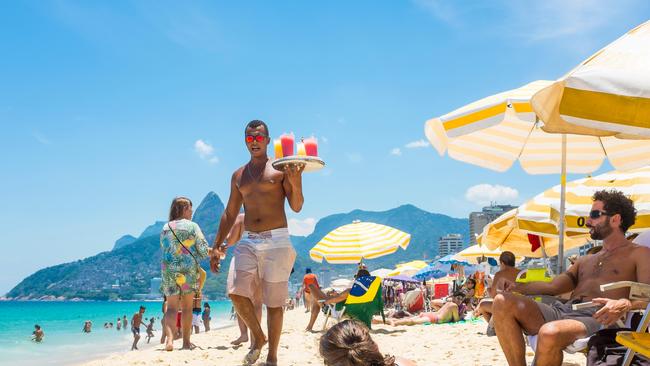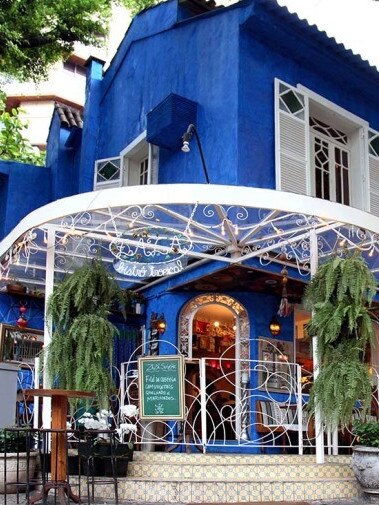Despite the crime rate, Rio is one of the world’s greatest — and most beautiful — cities
No one has mentioned how gob-smackingly gorgeous this city is, with its enormous harbour skirted by countless golden beaches.

It starts with a warning about pickpockets, and culminates with a news report, just before we leave for the airport, that the country to which we are headed has more homicides than anywhere else, with a person violently killed every 13 minutes.
By the time we land in Rio de Janeiro on a balmy summer’s day we have been saddled with warnings to carry minimal cash and to leave jewellery at home. And we have absorbed a long and alarming list of alerts on the federal government’s Smart Traveller website: “Violent crime, including mugging, armed robbery and carjacking is common … Don’t go out alone at night. Avoid isolated areas, including beaches … If you’re driving yourself, keep doors locked and windows closed”, among a litany of terrifying possibilities that also covers food and drink spiking and kidnapping.

So when we finally step out of Rio’s Galeão International Airport at the precise point where our pre-arranged private transfer is due, our phones, which we might have otherwise consulted, are securely locked away. (“Petty crime such as bag or phone snatching is common.”)
But we are also amazed. Because amid all these dire words, no one has mentioned how gob-smackingly gorgeous this city is, with its enormous harbour skirted by countless golden beaches, its multitude of rocky outcrops, the lushness of its many verdant streets and the sheer beauty of the late afternoon clouds that gather over its coastal mountains.
Rio is a stunning city that sizzles far beyond its famous beaches. And in the days that follow, possibly because we encounter nothing untoward (which in turn is possibly because we reluctantly avoid several crime-prone areas) we ease into its relaxed rhythm and discover a lively city with countless jaw-dropping views.
In a metropolis that is home to 6.6 million people, there is a lot of turf to cover: from the astounding outlook atop Sugarloaf Mountain, to the jungle drive to visit the mighty Christ the Redeemer statue, and across the harbour, via the massive 13km-long Rio-Niterói Bridge to see Oscar Niemeyer’s spaceship-like Contemporary Art Museum.
But it’s on the city’s famous stretches of sand that we observe an altogether different life. The surrounding cafes may feature many standards of Australian cafes – banana smoothies, avocado on toast and the locally beloved açaí bowls – and the beaches are familiarly thrumming with life. But they are also frenetic stretches of commerce.

From morning until late in the day (hotel staff warn us to stay off the beach at night) there’s a constant parade of trade. Without so much as standing up from your beach towel or rented chair and umbrella, you can acquire everything you need for your seaside stay, and then some: sunglasses and swimsuits, sarongs and sun dresses, speakers, cigarettes, balloons and even necklaces. You can grab a cocktail from the platters being proffered by countless roving sellers, and munch on hot corn or sausages, or popcorn, sandwiches or even pre-prepared packed lunches from any number of the vendors who drag their wares across the sand. The beaches are golden, and so deep at Copacabana that authorities helpfully provide long sprinklers to dampen and cool the lengthy walk out to the surf, which in turn proves to be surprisingly coolish in summer (it is the Atlantic) though not quite crystal clear.


And then there’s the wonder of just strolling along these famous stretches. Walking the 3km shore that links our Copacabana beachfront hotel to neighbouring Ipanema, it’s hard to avoid humming any number of Rio-related songs as we drift from surf to sand, stopping at a waterfront cafe for a coffee, considering a multipurpose sarong from a roving vendor who deftly shows dozens of ways it can be worn, and finally just sitting on a low fence, beachside, to take in the life that surrounds us.
On either side of Copacabana Fort, which divides these two famous spots, the beaches are studded with bodies of all shapes and sizes, being strutted in vibrant swimsuits whose price tags, at the many local boutiques, seem to be inversely proportional to their fabric content. Crowds are gathering at hotly contested games of beach volleyball. And everywhere there are surf skis and kayaks waiting to be wet. With few surfers in the mostly calm sea, all the action is happening on shore, where life, it seems, is really a (famous) beach – or two.
Checklist
Getting there: Qantas and LATAM have regular flights between Sydney and Santiago, Chile, from where multiple airlines operate four hour direct flights to Rio de Janeiro.
Must do: Because of the crime rates, not to mention the sheer size of the city, organised bus tours are a good option.
Be sure to include stops at two of the city’s most famous locations, Sugarloaf Mountain and the massive Christ the Redeemer statue – access to both of which can be tricky for those with a fear of heights.
Eat: A street back from Ipanema beach, Zazá Bistrô Tropical sits in a charming old house and offers a delicious, contemporary menu. The generous cold starters plate, which includes labneh with truffled honey, ceviche with mango sorbet, and tuna and salmon tartare on a crunchy tapioca disc, is a great option for those unable to whittle down the list of tasty offerings. instagram.com/zazabistro

Stay: Like many of the beachfront hotels that line waterfront Avenida Atlântica, hotel Windsor California Copacabana affords views of two of Rio’s most famous sites. Copacabana Beach, which is just across the road, looks especially lovely at night from the rooftop pool, while the restaurant that adjoins the pool looks out to the Christ the Redeemer statue. Rooms here feature a variety of outlooks. Those away from the beach might lack views but tend to be quieter. windsorhoteis.com

